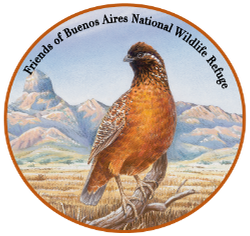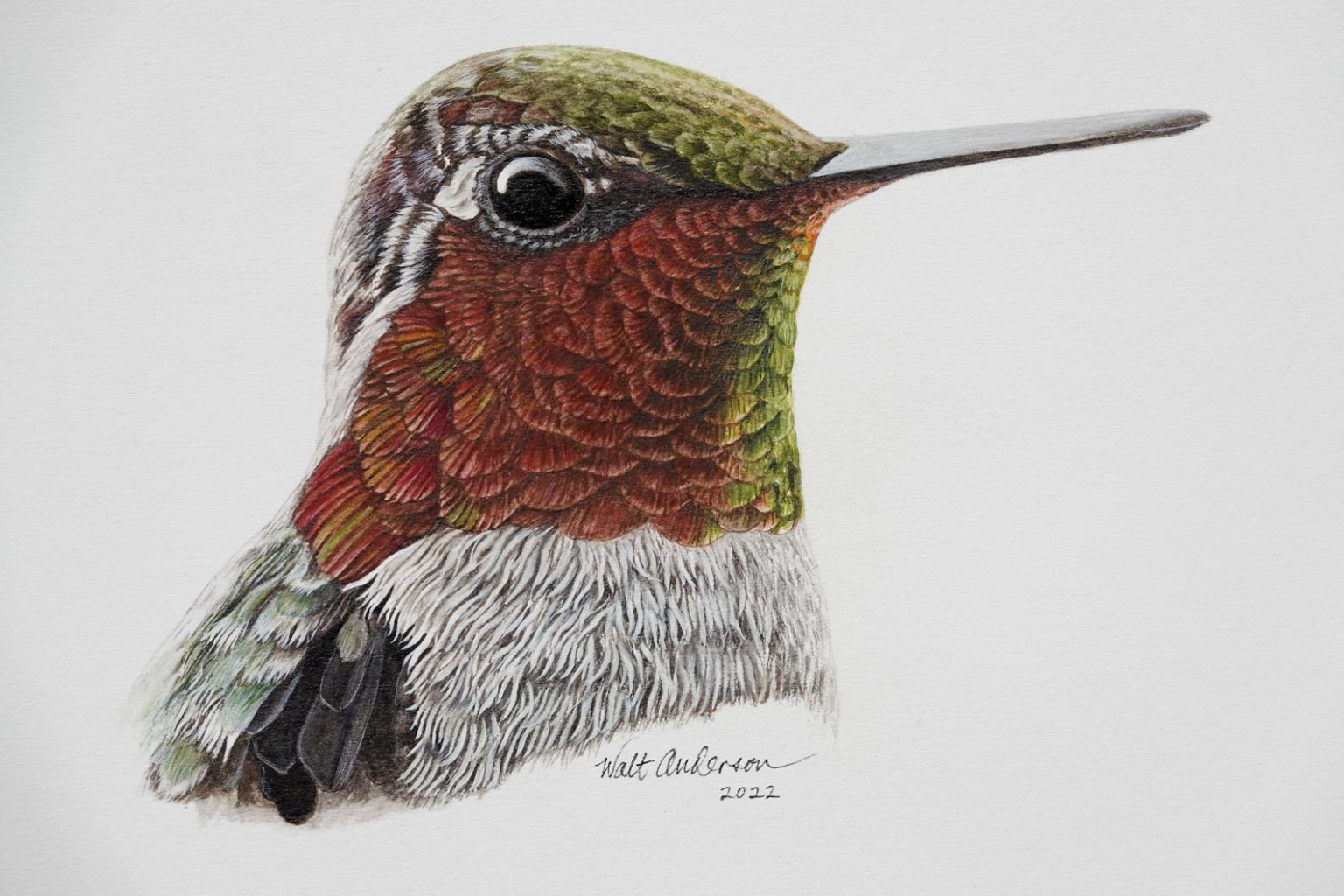
National Pollinator Week
by Walt Anderson
Today is World Camel Day, and though I admire the lanky beasts, I chose instead to call our attention to National Pollinator Week. Early plants relied on spores for reproduction, and some present ones (e.g., ferns) still do. Wind served to disperse the pollen of gymnosperms, and they had their heyday too, but it was the evolution of Angiosperms that relied on pollen transfer with the aid of animals that really caused a botanical revolution. Today, the great diversity of plants is dependent upon the even greater diversity of animals, particularly insects. Much of our food supply is dependent on pollinators of various kinds, yet our increasing reliance on industrial agriculture, along with its overuse of chemical fertilizers and “pesticides,” is threatening native biodiversity and sometimes even the future of the plants we depend on.
Yesterday was the Summer Solstice, the longest day of the year in the Northern Hemisphere, and warm days, as long as there is sufficient moisture, produce a profusion of flowers that in turn attract visitors, some honest pollinators and others there for other reasons (e.g., nectar thieves and predators). I love these interactions; a crab spider lying in wait for an unsuspecting pollinator is much more accessible to most people than actually viewing a lion ambushing a zebra.
So it is with great enthusiasm that I share a few examples of the birds, butterflies, true flies, and bees that interact with flowers. In addition to photos, I want to share a few of my paintings of specific pollinators. My goal is to encourage all of you reading this to get out there, stick your noses into some corolla tubes (exercising due caution!), and watch the dramas and the extraordinary beauty that flowers and their visitors can display. Shut down your electronic devices (and those that your kids may be addicted to) and discover the stories that are just outside your doorstep—in your gardens, parks, and wildlands.

I finished this watercolor just a few days ago, so this is its coming-out party. The Anna’s Hummingbird is a pollinator that you are unlikely to overlook. Not only is it flashy in its dazzling iridescence; it is feisty and bold. If you are wearing red, it will fly right up and check you out, no doubt disappointed in your floral failures. We get Anna’s that spend the winter here in central Arizona, tolerating deep frosts and snow as long as they have nectar to sip. When flowers appear, they depend less on artificial feeders and venture out to probe the flowers with their long beaks, transferring pollen that they picked up at the last similar flower they visited.
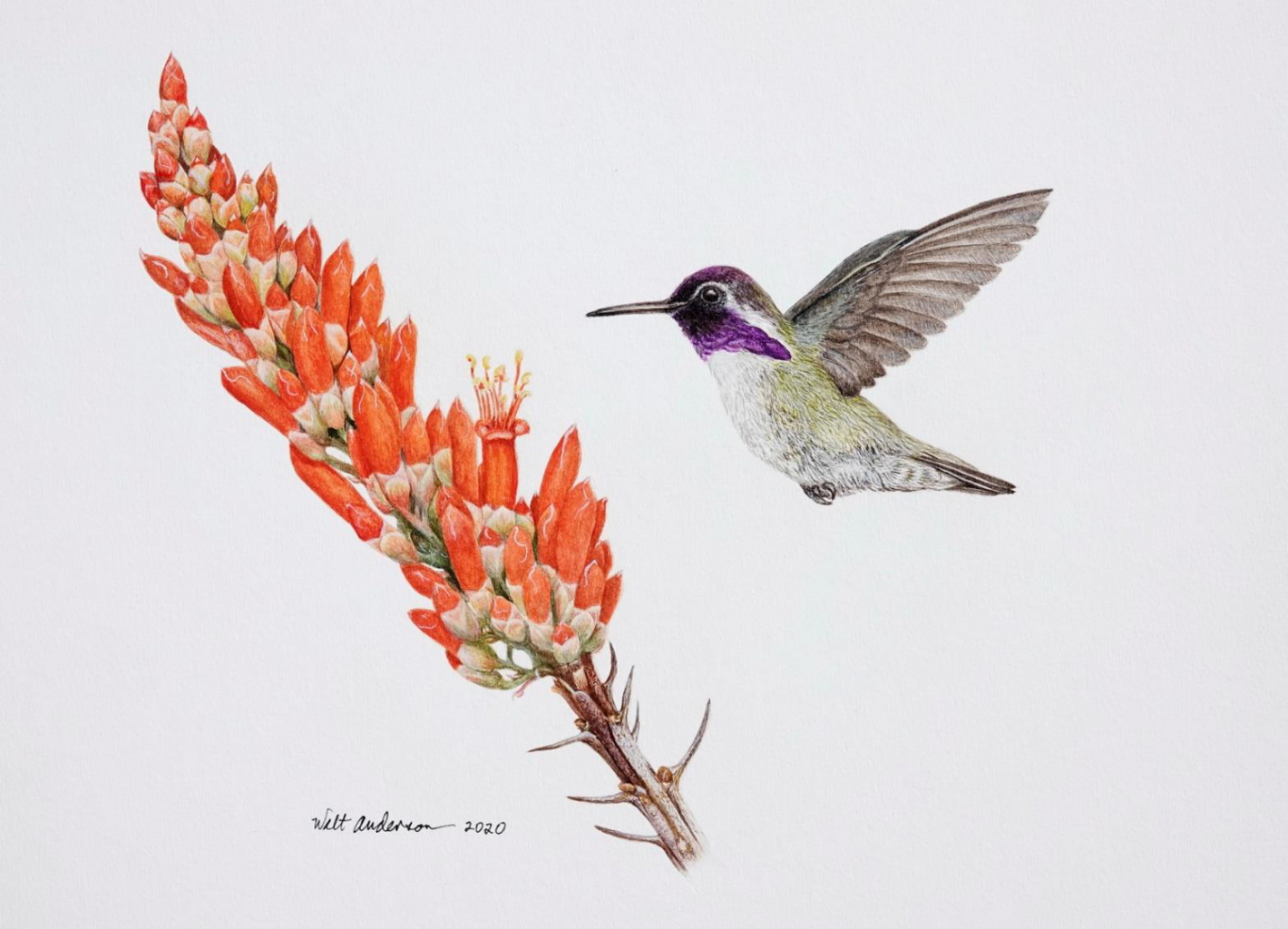
Many flowers have evolved traits that make them attractive to hummingbirds: long floral tubes or stamens, bright red or orange colors, copious nectar, lack of scent (which bees tune in on), and daytime nectar production. We can typically see at a glance that this inflorescence of an ocotillo is a hummingbird flower, here being approached by a Costa’s Hummingbird. Most bird-pollinated flowers evolved from kin that were serviced by bees or other insects. This has been noted in at least 37 families of plants, a wonderful example of convergence.
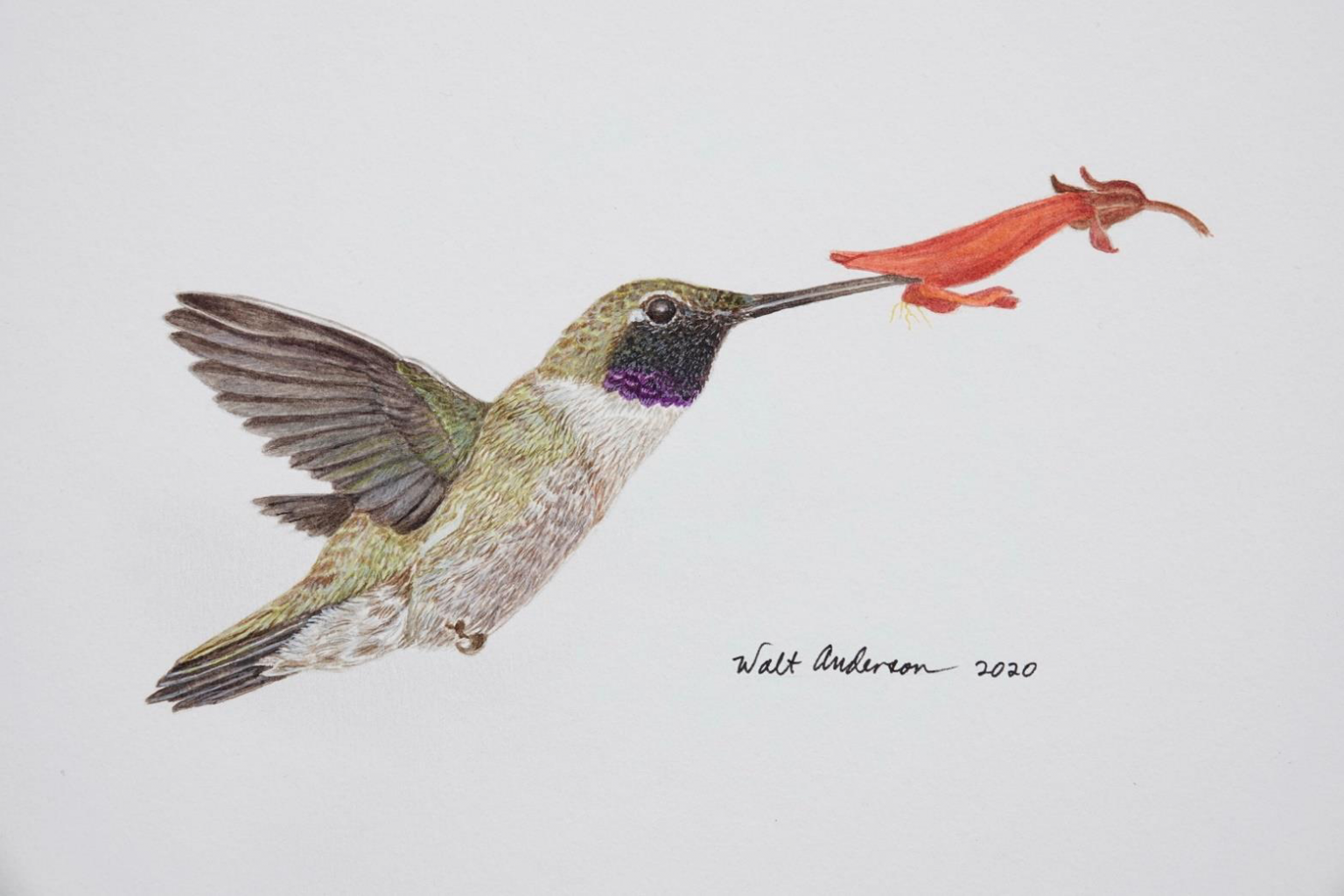
The long floral tube and lack of a secure perch favors hovering hummingbirds with their extended beaks and specialized tongues. This Black-chinned Hummingbird is sipping from a beardtongue, a Penstemon. Many hummingbirds are highly territorial, defending patches of flowers that provide sufficient nectar resources without being so rich that too many hummingbirds want the same resources. When that happens, a territory is not economically defensible. It can be a dogfight of feisty pilots strafing each other. Hummingbirds are simply delightful to watch, and you can improve your viewing chances by planting plenty of hummingbird flowers to complement your nectar feeders. Native flowers are certainly the best choice.
The Brazilian Portuguese name for a hummingbird is beija flor (flower kisser). How appropriate!
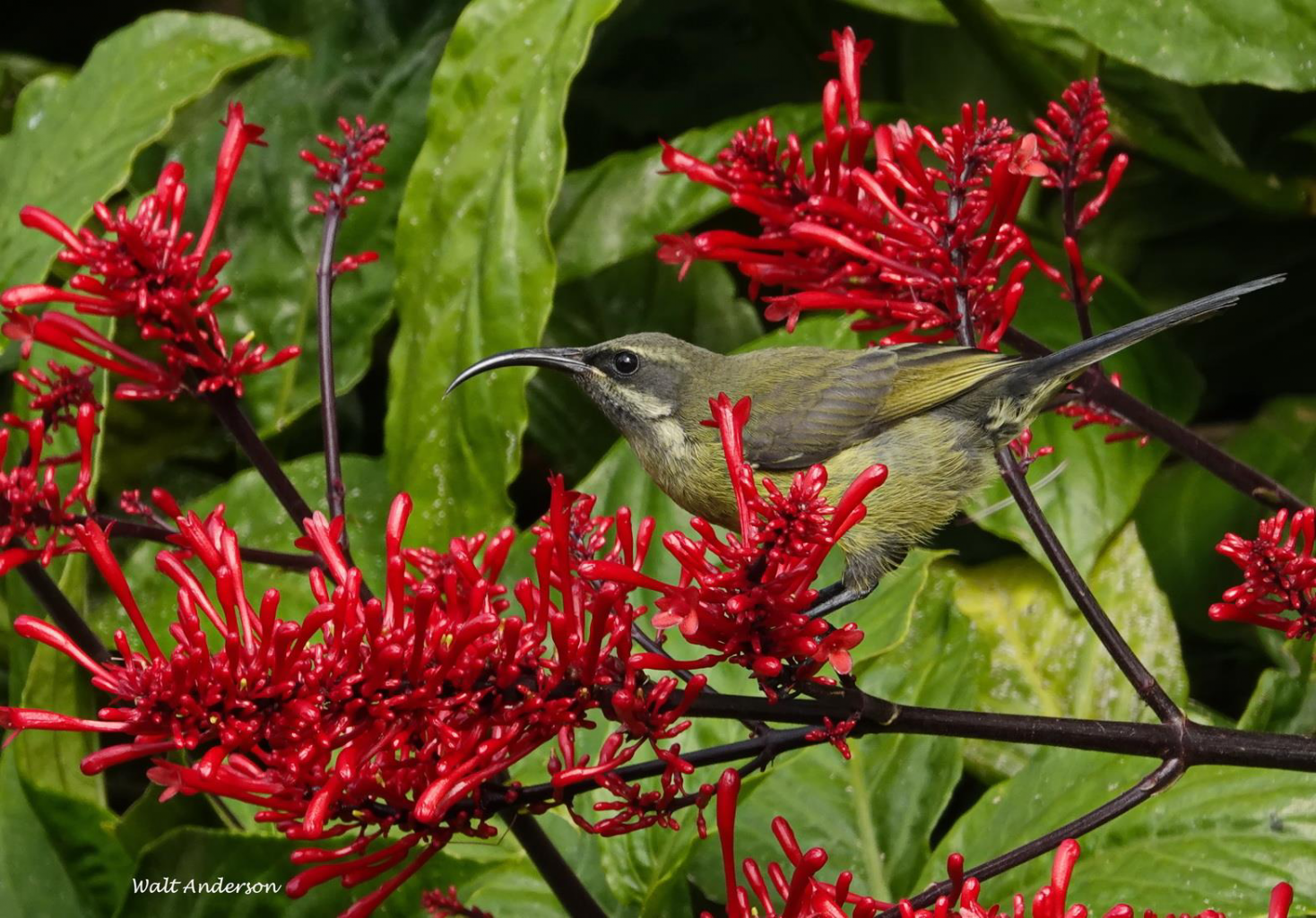
Hummingbirds (and there are more than 350 species of them!) are strictly residents of the New World. Each species has a distinctive niche, allowing as many as 140 species to coexist in parts of South America’s Andes. In the Old World, the basic hummingbird niche is occupied by sunbirds, completely unrelated. Here is a female Amethyst Sunbird in Tanzania; the male is blackish with a brilliant iridescent throat and crown, as well as a long, curved bill perfect for poking into curved tubular red flowers. Sunbirds and hummingbirds also illustrate convergence, and the plants they prefer do the same! Evolution is so cool!
Buchmann and Nabhan in the wonderful book, Forgotten Pollinators, report that “over 1500 bird species in at least 18 families have been reported as effective pollinators of plants.”
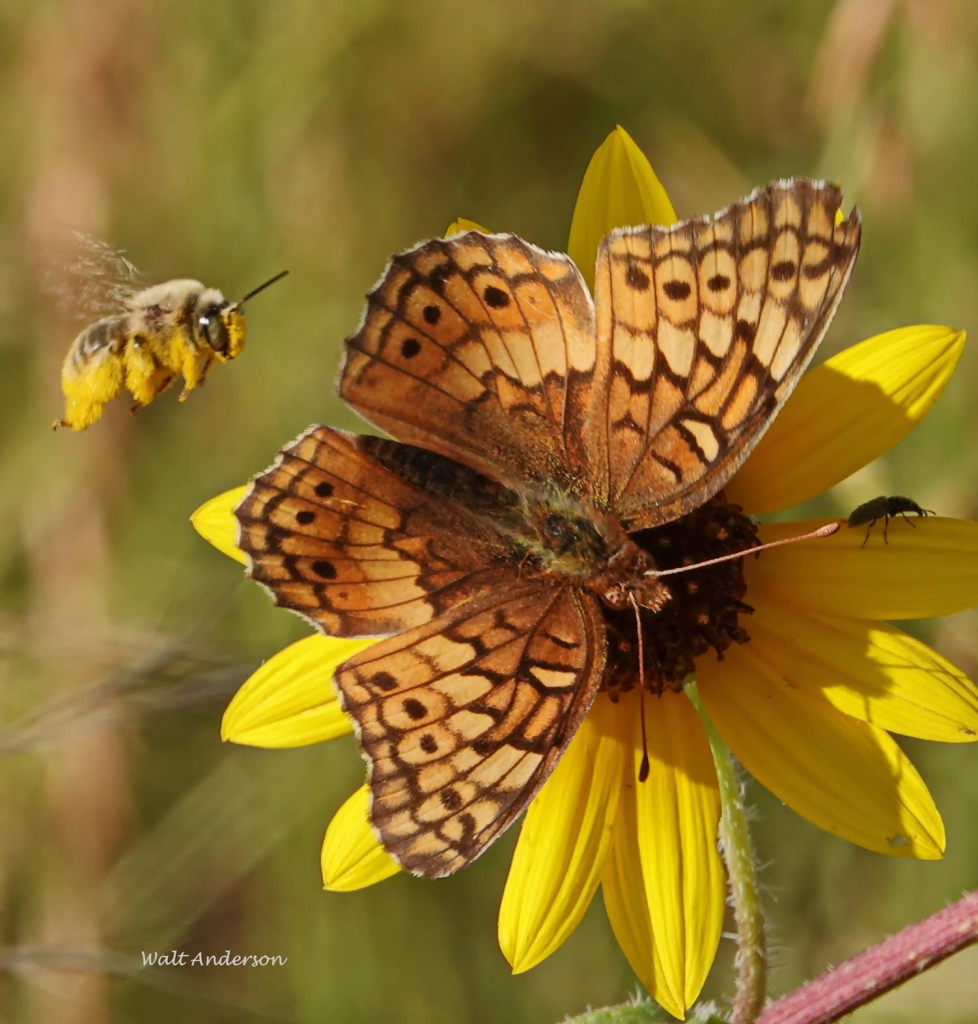
Sunflowers are designed to appeal to insects. This fuzzy bee, a Variegated Fritillary butterfly, and a weevil all are attracted to this showy platform. The sunflower head, of course, is an inflorescence of perhaps more than a hundred disk flowers and about a dozen ray flowers in this case. Clustering like this enlarges a target for pollinators; having many inflorescences per plant further tiny enhances the target effect. No hummingbird in its right mind would bother with the tiny urns of nectar in those disk flowers, nor would an astute bee try to nectar on a red penstemon. Flower design not only acts as a target for appropriate visitors, but it also can create filters limiting access to certain ones.
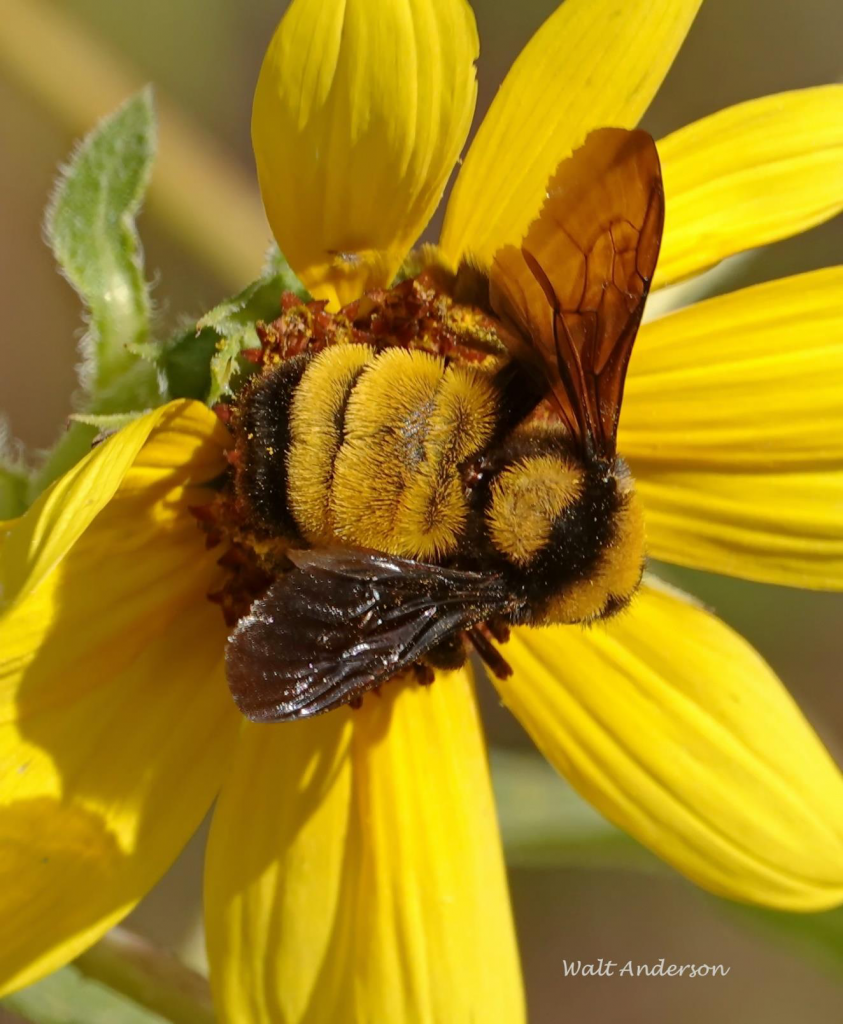
A native bumblebee needs a substantial landing pad like that provided by a sunflower. Bumblebees are truly amazing creatures. For a long time, physicists couldn’t figure out how such a bulky body could fly with those pathetic wings. But fly they do! Sadly, many bumblebee species are now threatened or endangered. It’s all out fault, of course. We have banned some harmful pesticides, but the chemical industry has powerful political connections. It is time for us to speak out and get our politicians to ban neonics (neonicotinoids), which are pesticides that are taken up in pollen and nectar, thereafter poisoning bees. They aren’t good for us either!
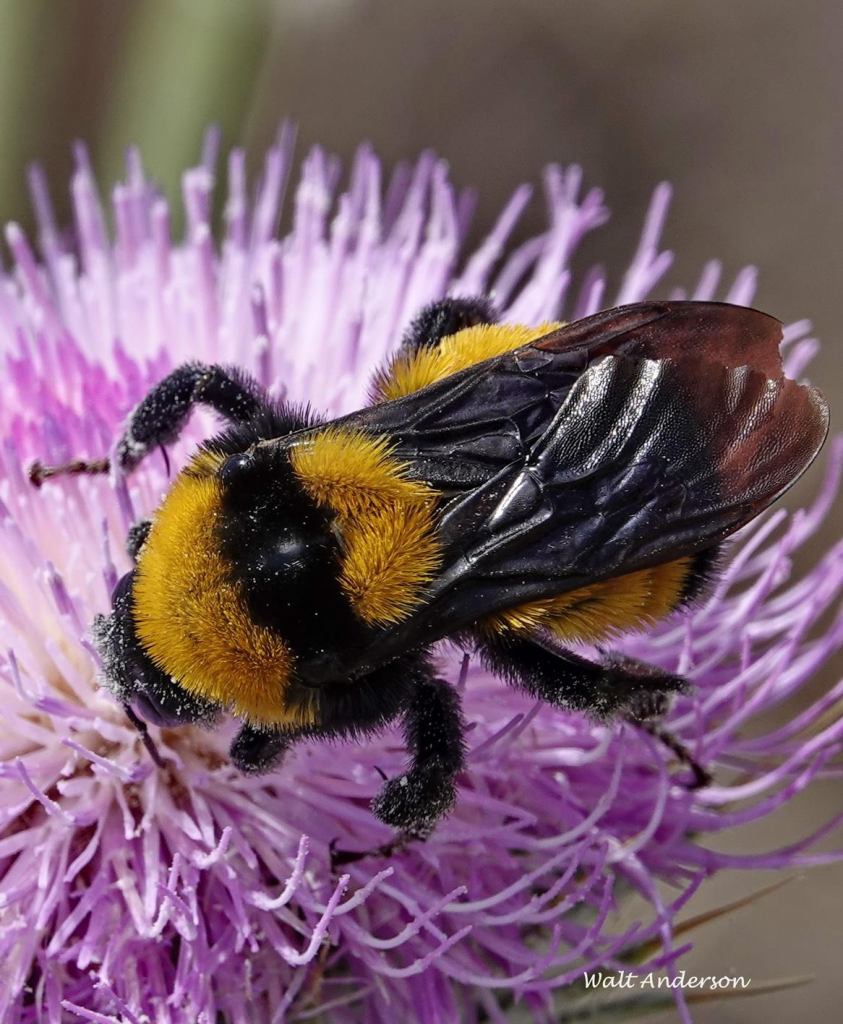
Thistles are composites too, and when a bumblebee saw one on a humid morning, he said “thistle dew.”
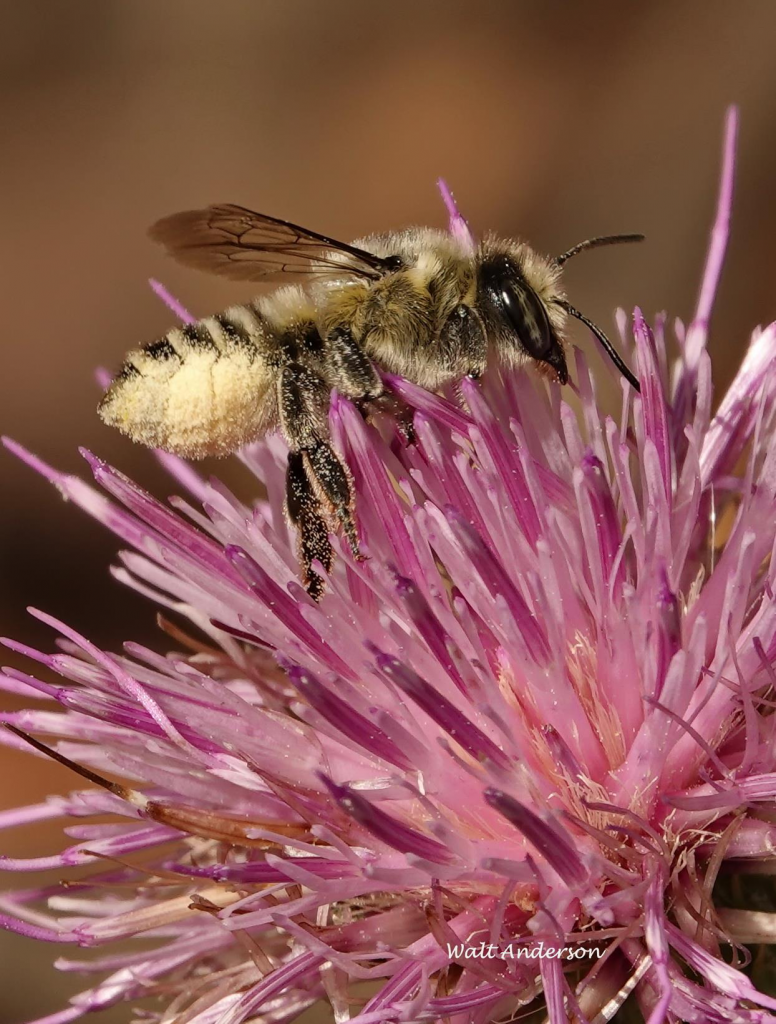
A megachile bee visits a Yellowspine Thistle. Notice the pollen on its “fur.”

The metallic green iridescence of a sweat bee is certainly as pretty as the iridescence on a hummingbird, but we tend to be oblivious to its charms because of scale. This is the bottom line on an eye chart, and for most of us, it takes some aid to see it well. Close-focusing binoculars are ideal tools for entering this world of hidden beauty. These days, excellent optics are allowing good birders to expand their game to identify butterflies, bees, “odes” (dragonflies and damselflies in the order Odonata), grasshoppers, beetles, and more. If the optics are good enough, you can probably determine the lesser of two weevils.
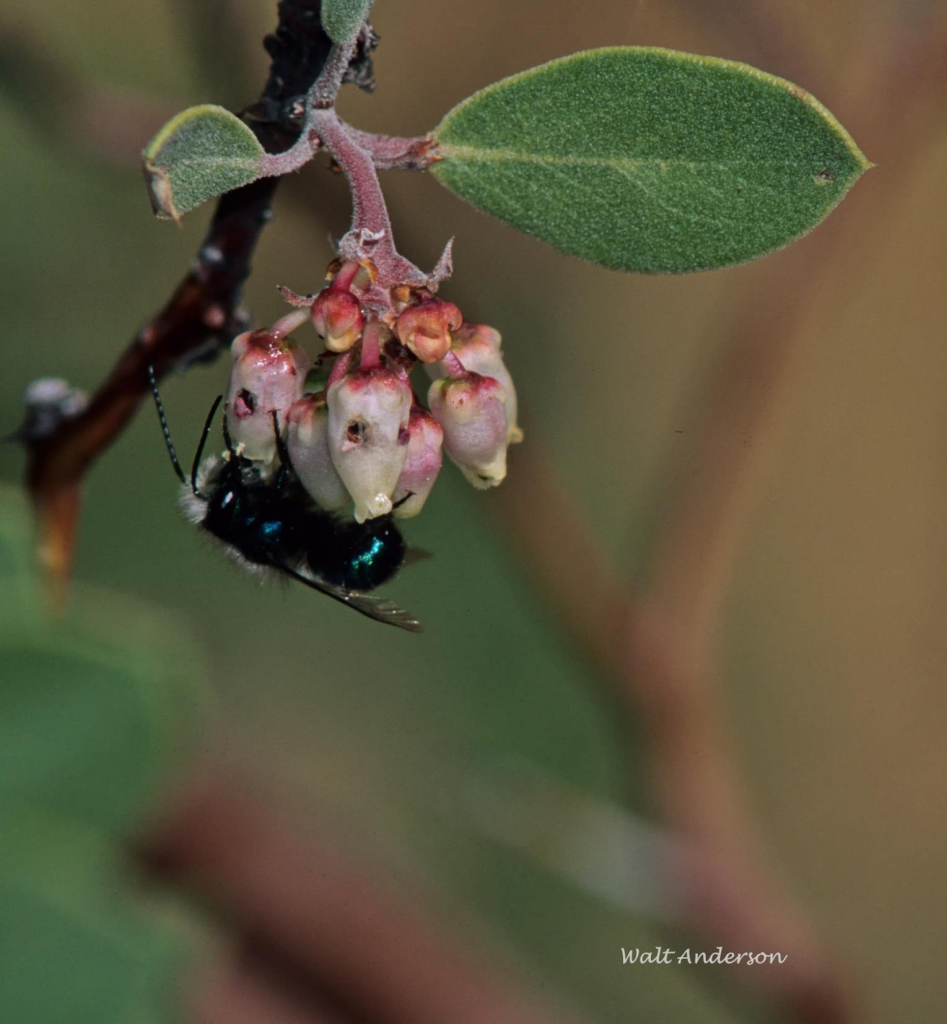
Manzanita flowers, often one of the early sources of nectar at the end of winter, are fairly choosy about their pollinating partners. They only produce pollen, no nectar, and the pollen is protected in tight pores that honeybees and others cannot get into. Osmia bees are buzz-pollinators (or sonicators), and by vibrating their wings at certain amplitudes and frequencies, they cause the release of pollen. They and other buzz-pollinators are very efficient in their work. The small holes in the flowers shown here are caused by thieves—insects like the honeybee that punch holes in the flowers and take pollen without effecting pollination. Bad form!

A cactus bee (Diadasia) emerges from the pollen-rich flower of an Englemann Prickly Pear. Cactus bees are specialists, focusing on the flowers of cacti. One species is a significant pollinator for the saguaro in the northern part of its range.
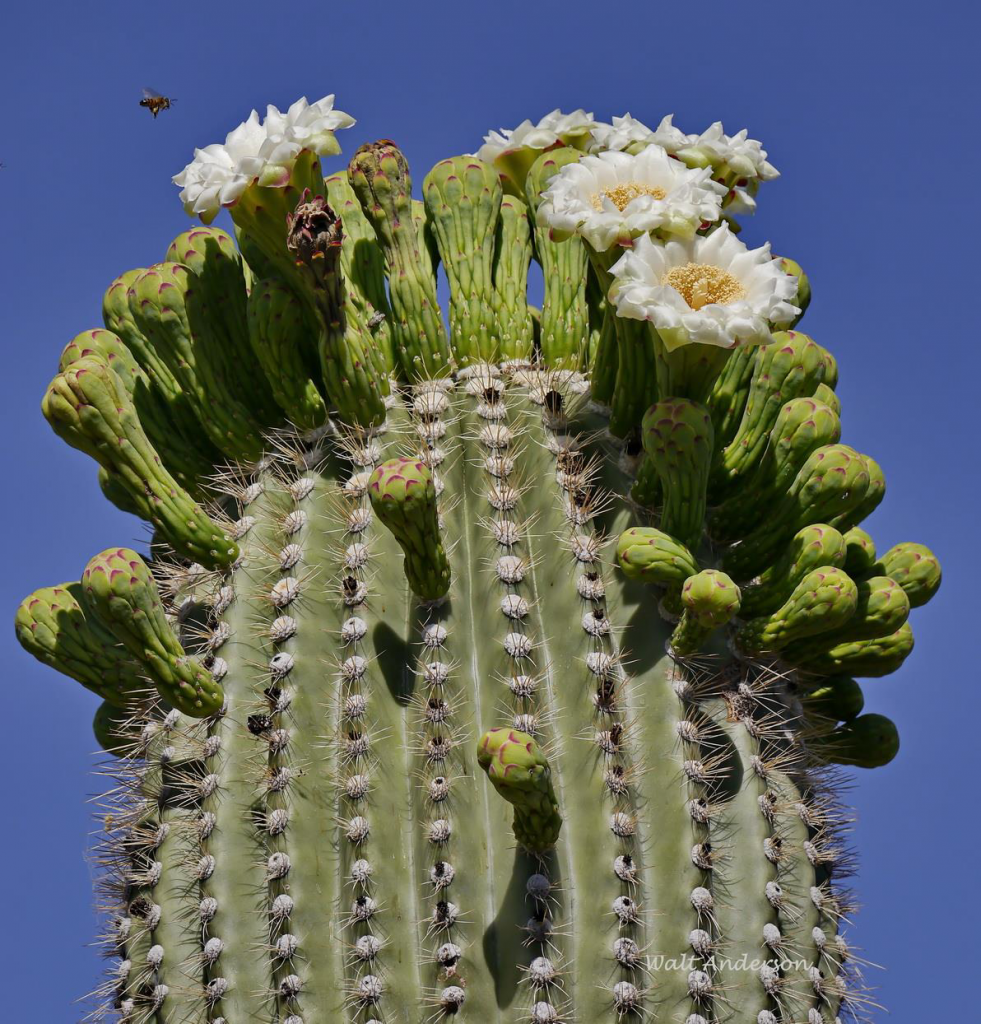
Just as hummingbird flowers tend to have predictable features, so too do the blossoms that typically are pollinated by bats. They tend to be large, white or creamy, very fragrant, loaded with dilute nectar, and night-opening. In Mexico, several species of nectarivorous bats pollinate saguaros, agaves, and other desert plants. Here in Arizona, however, these bats barely cross the border, yet the saguaros do get pollinated by native cactus bees, non-native honeybees, and birds like White-winged Doves. Clearly, it can pay not to put all your eggs in one basket.
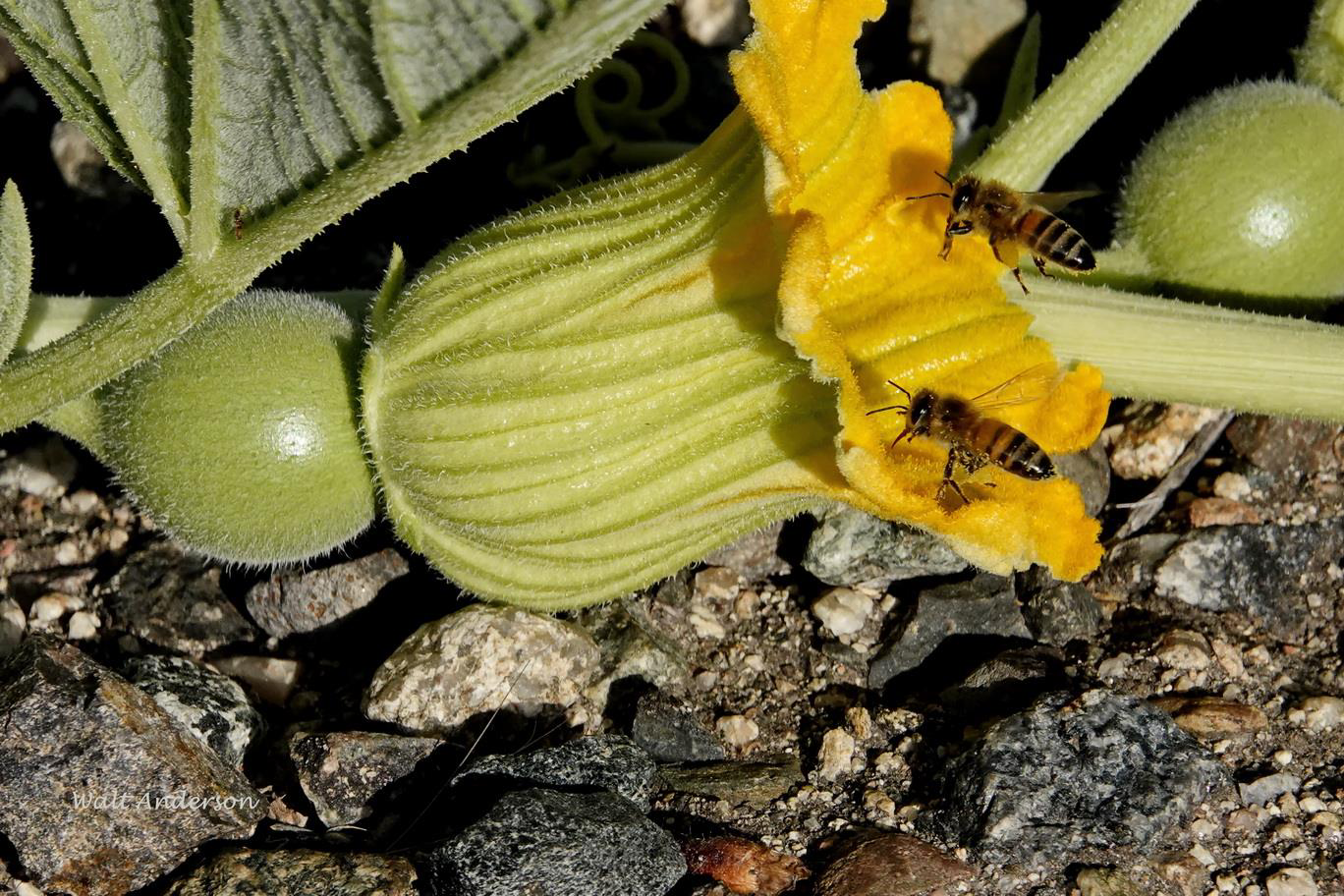
Two days ago, I came across this flowering Stinking Gourd (Cucurbita foetidissima) along the highway. I always avoid stepping on the arrow-shaped leaves of the vine, as its malodorous smell hangs on for far too long. The large flowers, however, are quite attractive visually. They open around 4 AM and draw in several native squash bees, usually well before before the non-native honeybees start their business, and they close by 9 AM. Squash bees are very effective pollinators of these gourds, as well as domesticated pumpkins and squashes. After their early morning buzz fests, a good number of these bees will curl up in the withered blossoms for a good rest.
Since non-native honeybees don’t buzz-pollinate, they make lousy pollinators for many plants, both wild and domestic. Buzz pollinators include squash bees, bumblebees, sweat bees, mason bees, carpenter bees, stingless bees, flower bees, digger bees, plasterer bees, leafcutter bees, mining bees, and more. Of course, none of these bees produces honey in quantities that people can exploit—thus the human mediated replacement of native bees by billions of introduced honeys. Many species of plants (including tomatoes, potatoes, and other solanaceous plants; blueberries and cranberries; pumpkins and squashes) do best with buzz pollination (I like a little buzz myself when I get up in the morning). It’s not surprising, then, that many “nativists” dislike the honeybee, particularly now that the more aggressive Africanized bees have spread in the Americas.
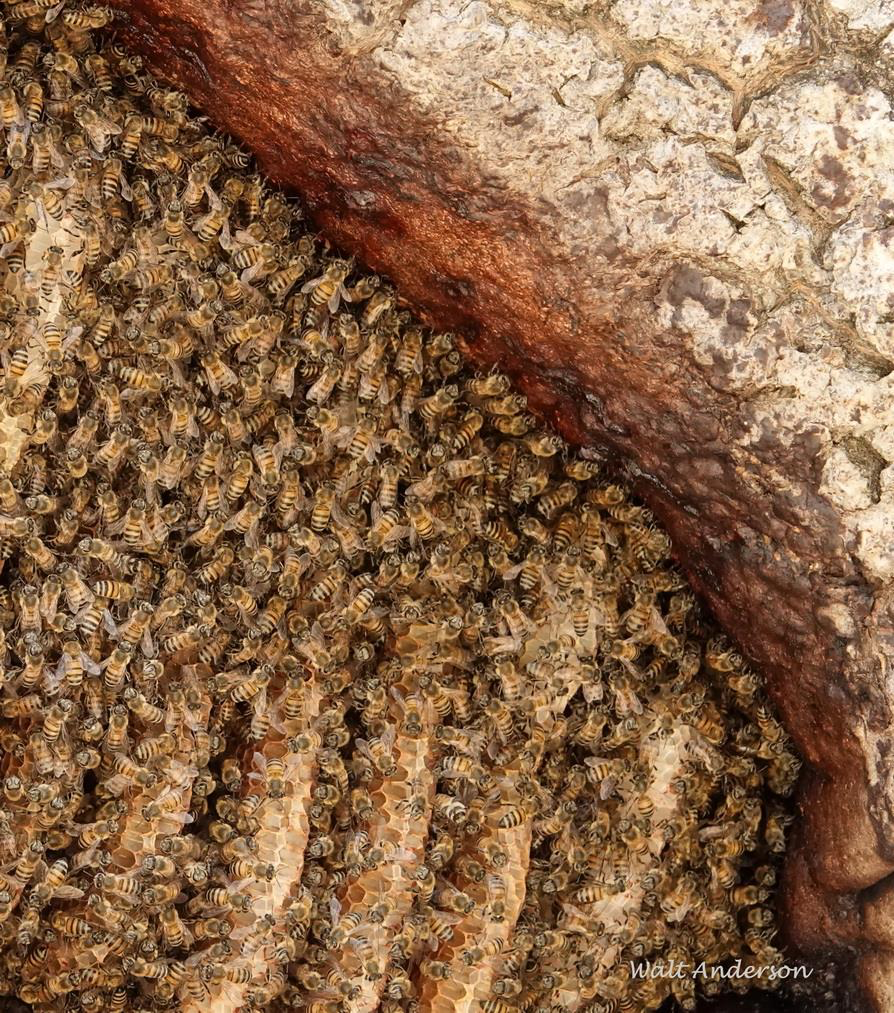
Here are true African honeybees, a colony nestled in a niche, perhaps created by the tusks of an elephant, in a giant baobab tree in Tanzania. Hunter-gatherers in Africa, along with animals like the honey badger and several species of birds called honeyguides, have co-evolved with African honeybees, which are an important element in various ecosystems. While safari-goers may be looking for the Big Five and other megafauna, I encourage my trip participants to pay attention to the little things too, as they add so much to a learning experience.
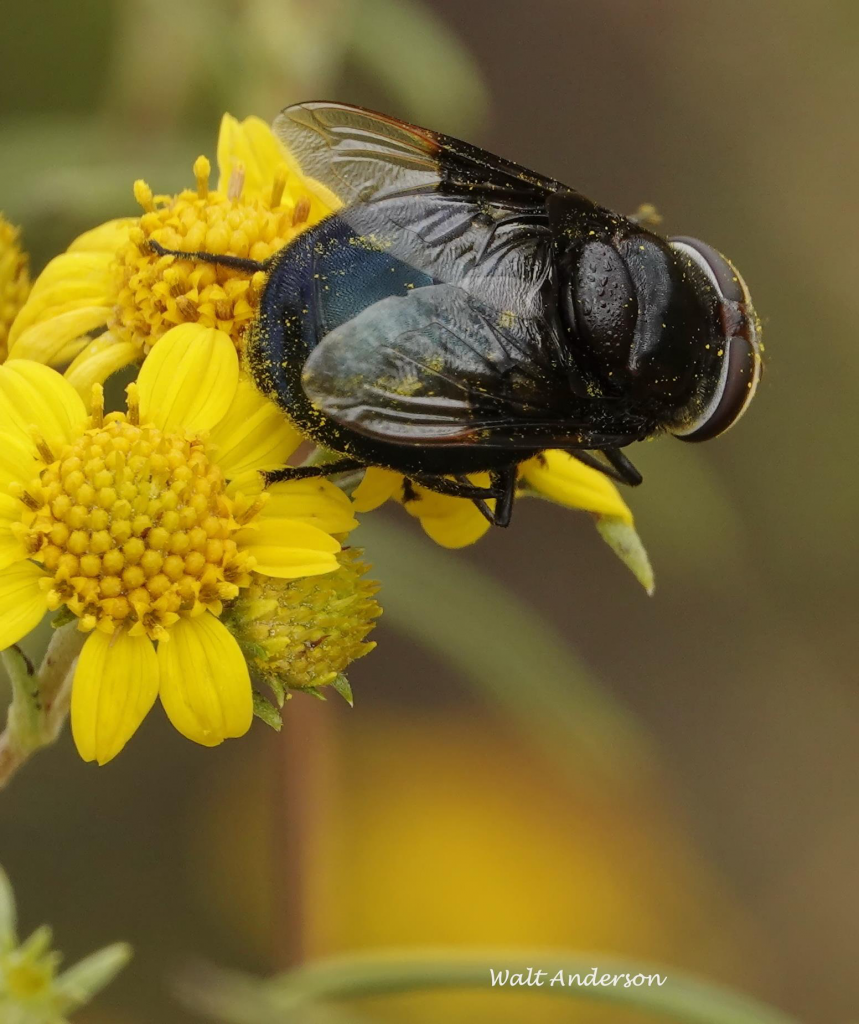
While we tend to think of bees as pollinators, there are plenty of wasps, flies, beetles, moths, and butterflies that play that role. Here is a splendid cactus fly, Copestylum mexicanum.

Another fly that visits Annual Goldeneye is this horsefly with its gorgeous metallic green eyes. Its resemblance to a bee is no accident; this mimicry could save its life if a potential predator is wary about being stung. Female horseflies and deerflies can give us humans a sharp nip if we aren’t careful. They sense your sweat and carbon dioxide and come in for a meal of blood that provides protein needed for the development of their eggs. Notice the “inchworm” on the right. I had no idea it was there when I took the photo.
The horsefly first appeared in literature around 460 BC when the Greek playwright Aeschylus, the “father of tragedy,” described these persistent little beasts as capable of driving one mad. He had two sons, both authors of tragedies, so I guess there was a Mother of Tragedy too. If you have been bugged by a vicious mother horsefly, you might consider it a minor tragedy, painful but not fatal.
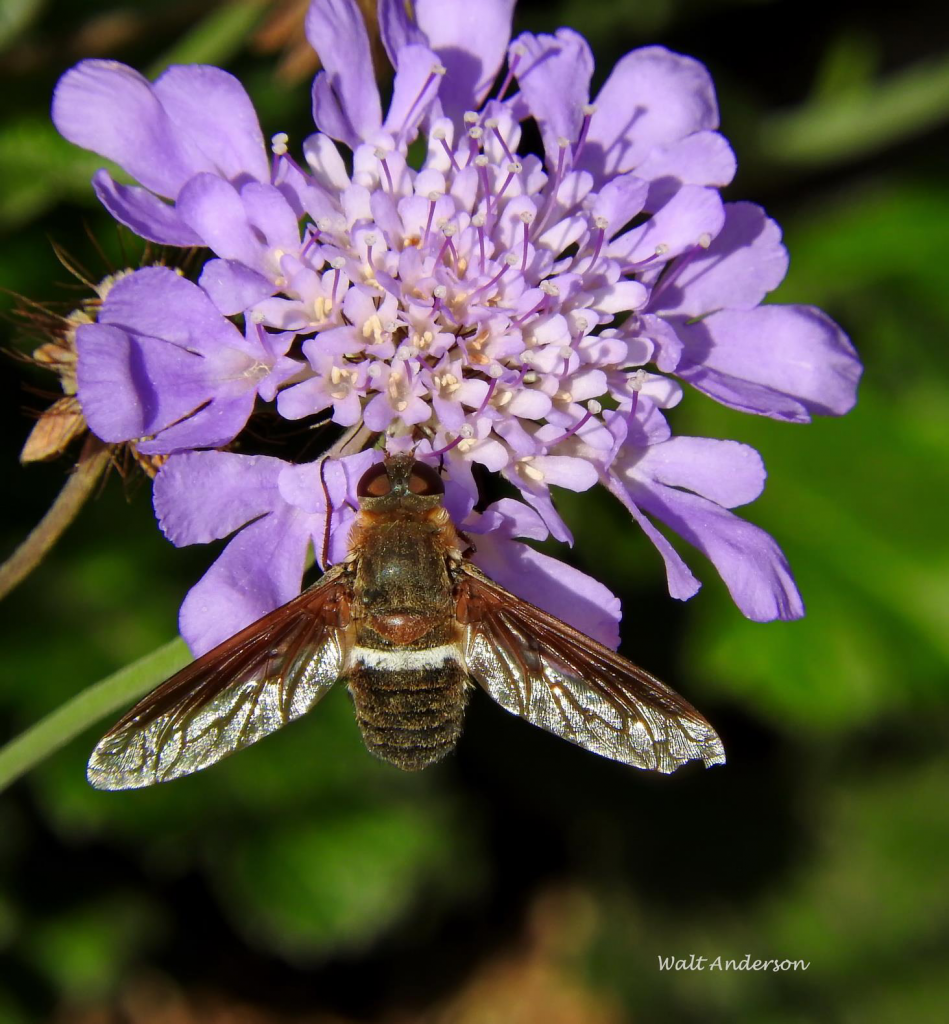
The Progressive Bee Fly (Exoprosopa) is another bee mimic, which is probably useful to give insect predators pause before attacking. While it seems like an innocent flower pollinator, there is a dark side to its reproductive behavior, as the fly searches out insect burrows to place its eggs such that the hatchlings parasitize the larvae of solitary bees and wasps, as well as those of robber flies. I ask, is that really progressive?
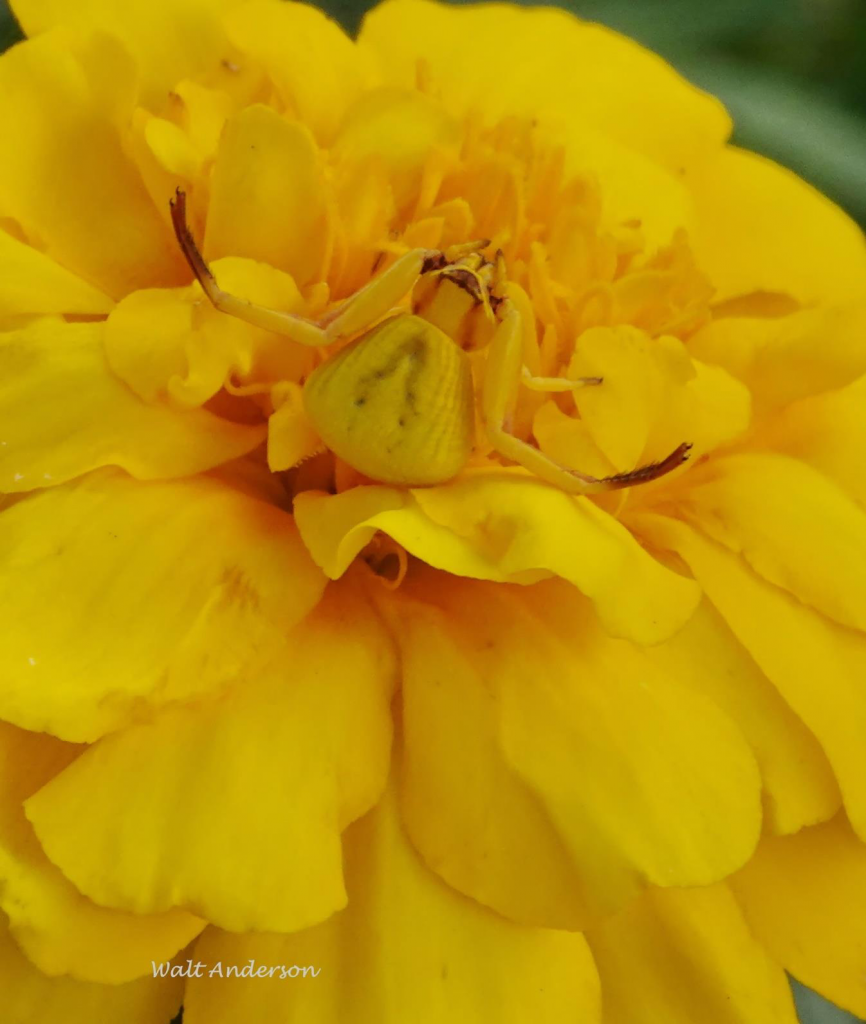
The physical beauty of flowers, the sweet scents, and the promise of delicious nectar or pollen is like a magnet to pollinating insects, but rewards also come with risks. What better place is there for a predaceous crab spider, perfectly camouflaged, to wait for dinner to come to it? The spider seizes its unsuspecting prey, injects some poison to paralyze it, inserts digestive enzymes into the insect’s body, waits a bit, and then sucks the digested contents in like having a milkshake. This is called “extracorporeal digestion,” good if you can pull it off. A study has shown, however, that success rate by these spiders is not so dependent upon their color matching the flower. Instead, the color matching best protects them from predation by a bird or other assassin.
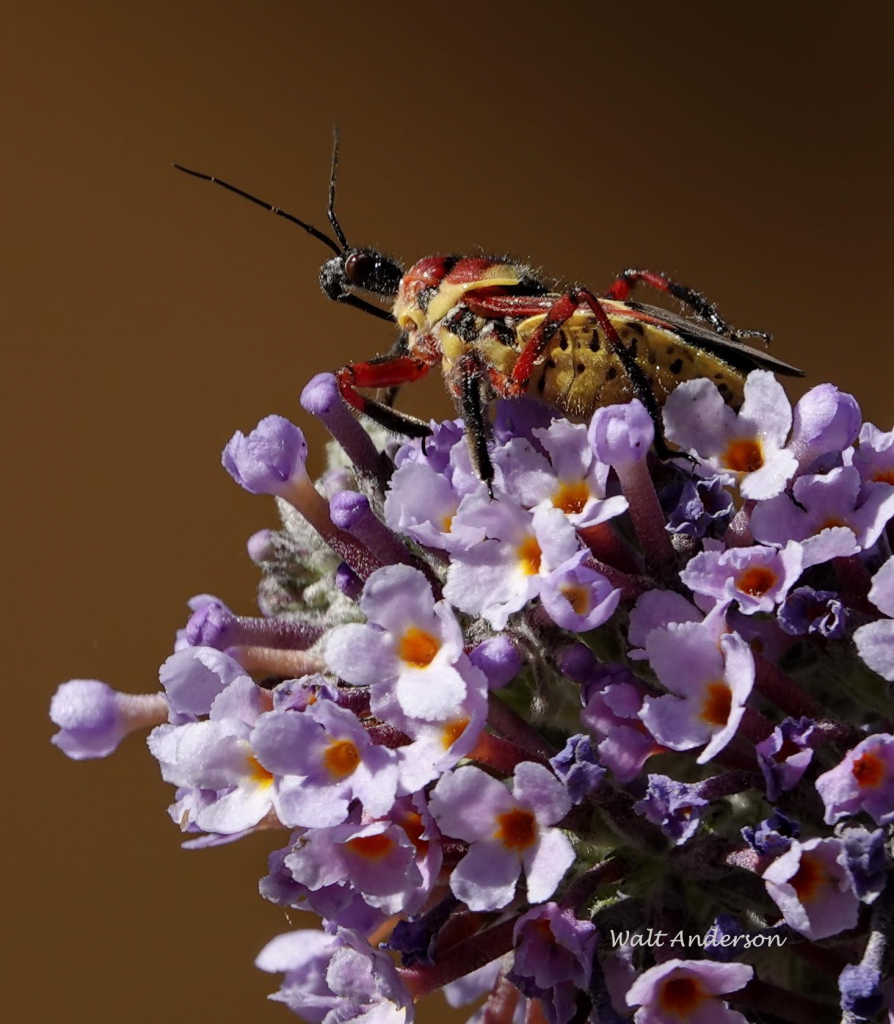
Speaking of assassins, here is a Yellow-bellied Bee Assassin, Apiomeris flaviventris. I take it that “yellow-bellied” doesn’t refer to cowardice but is rather literal. The bright colors are a case of aposematism, conspicuous advertising that the bearer is poisonous or distasteful. Presumably that keeps birds from attacking them. Poison dart frogs, coral snakes, and Monarch Butterflies are classic examples of aposematism. Clearly the warning colors don’t frighten off naïve bees, or the bee assassin would be named something else (if it even survived).

Another pollinator is this day-flying Corn Earworm Moth (Helicoverpa zea), also known as Cotton Bollworm and Tomato Fruitworm. Yup, those names mean trouble for gardeners or farmers. Estimated annual crop damage by the caterpillars of this species exceeds $100 million dollars, and pesticide costs to attempt to control it can be as high as $250 million, according to the unimpeachable facts listed in Wikipedia. I’m just kidding about Wikipedia being “unimpeachable,” but more authoritative sources agree, and one fruit crop known to be damaged is the Peach, which I guess is peachable.
Of course, there are plenty of nocturnal moths that do their pollinating tasks on datura, brickelbush, and the like—flowers that often emit their enticing fragrances at dusk or later.
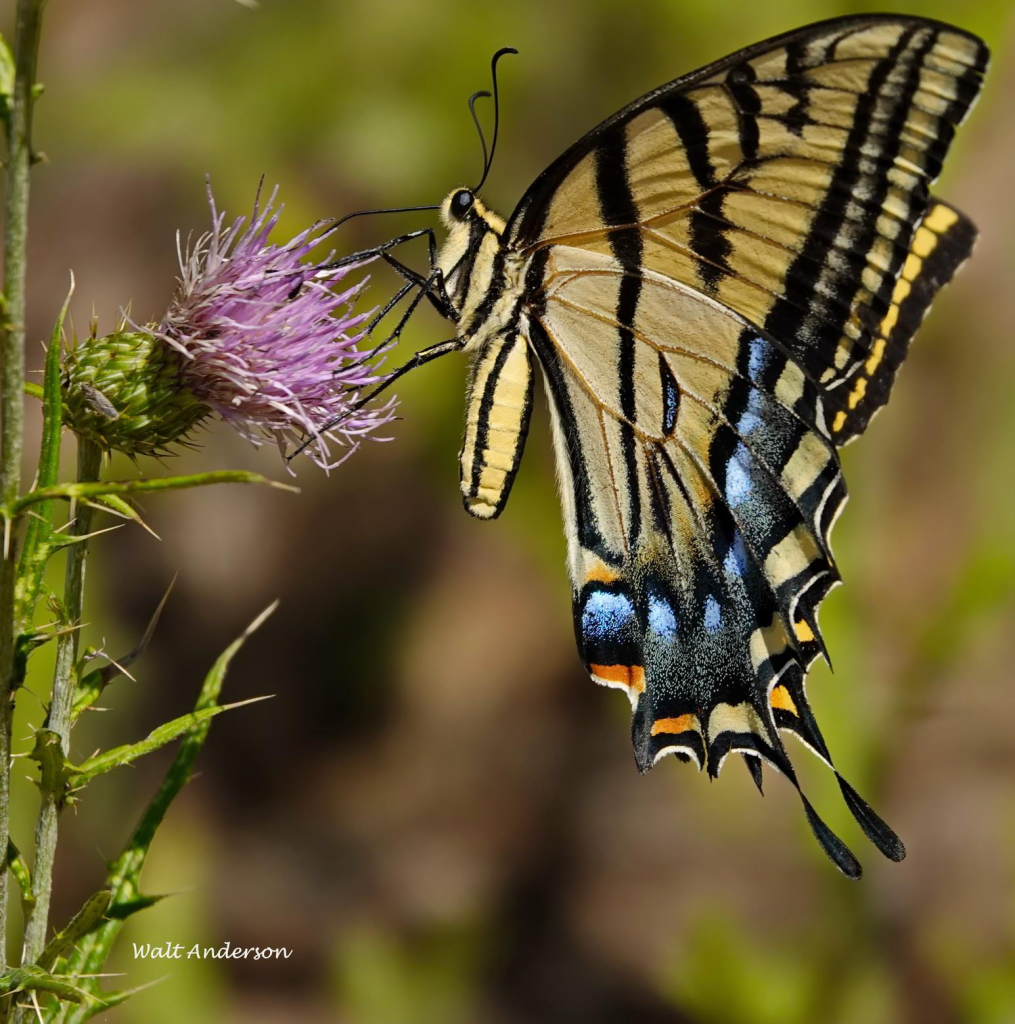
And there are the butterflies (a special group of moths, really), including the Two-tailed Swallowtail, the Arizona State Butterfly. What a gorgeous creature!
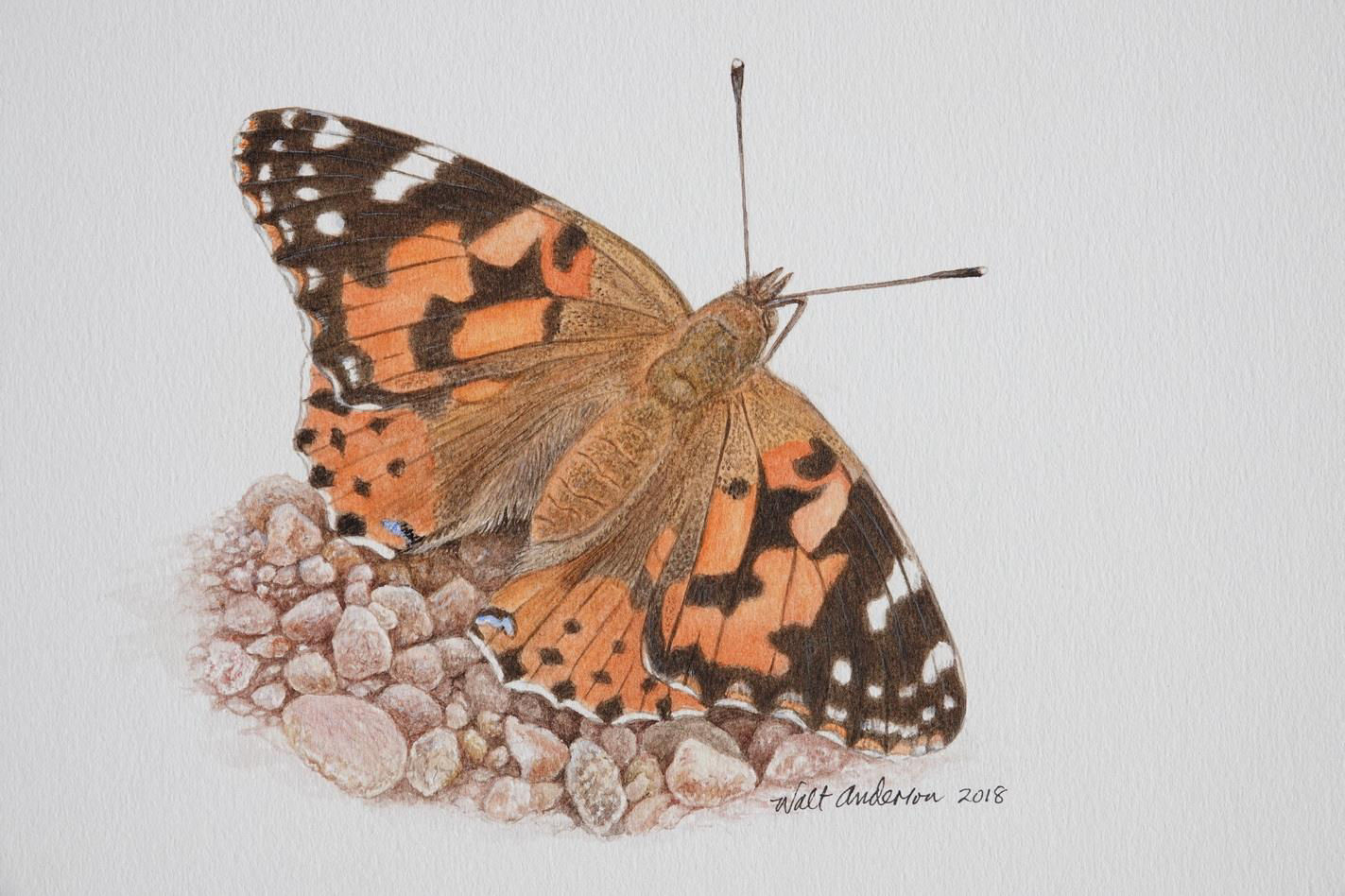
Many, though not all, butterflies are good pollinators, and the Painted Lady (also known as the Cosmopolitan because of its global distribution) is one of them. I love butterflies and did a series of watercolors of them back in 2018. Painting is surely a wonderful way to learn how a butterfly looks and functions. As I mentioned before, more and more people are getting close-focusing binoculars to observe (and to list) butterflies and other insects. Butterflies are challenging for a number of reasons: many are small, even tiny; they tend to fly erratically and sometimes won’t sit still for your careful observation; most have limited flight periods, so if you miss the temporal window, you are out of luck until the next year; size varies depending on caterpillar nutrition; some have specific larval host plants, so without the plants around, forget it; and some vary dramatically in pattern depending on sex or season. Then there are mimics, devilishly clever butterflies that look entirely like something else. Closely related species can sometimes only be told by their genitalia, which you are not allowed to touch. They also don’t have songs, which is often the best way to identify a bird. And so on! Nevertheless, the challenges are sometimes what make butterflying fun.
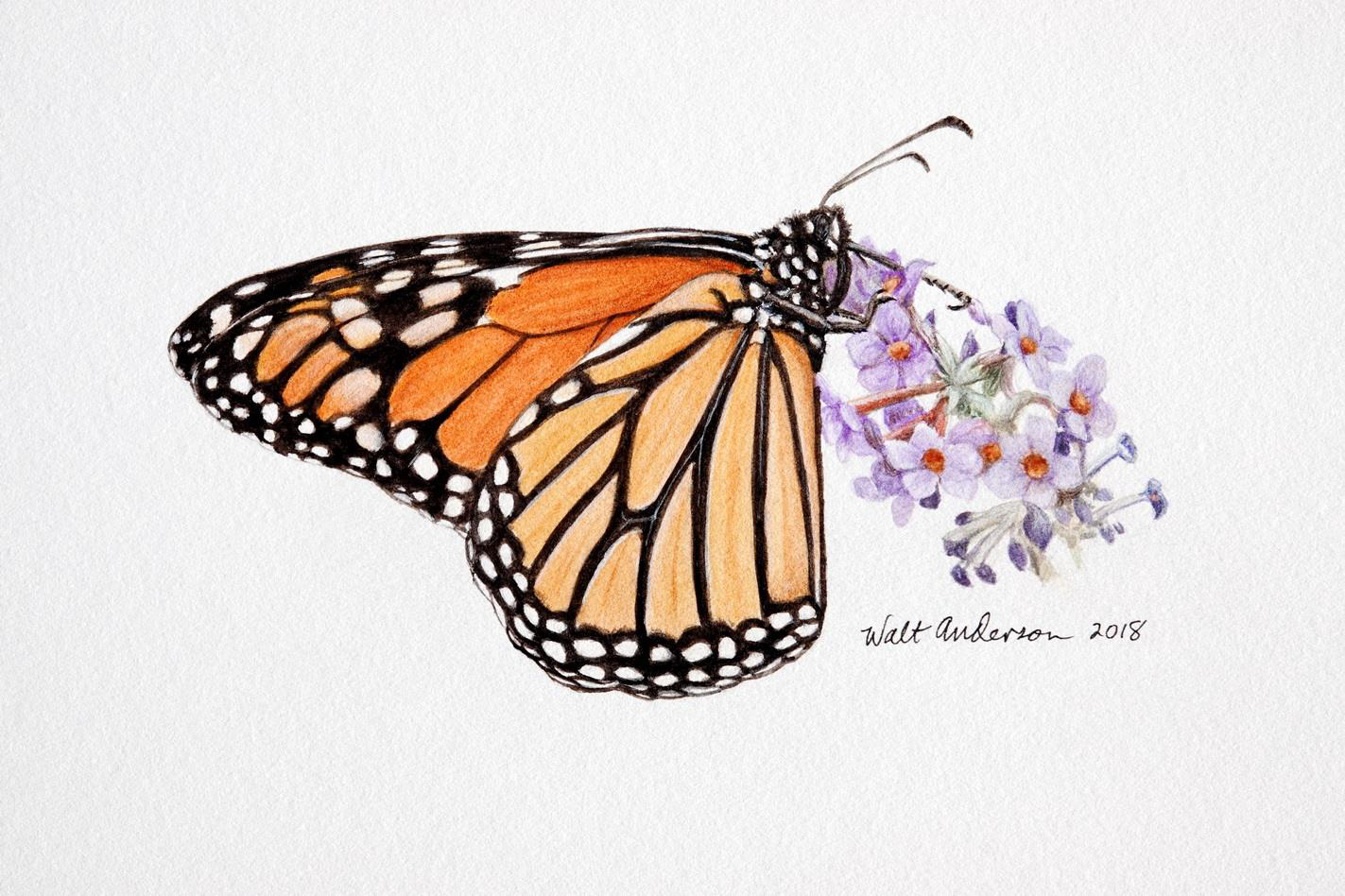
Then there is the Monarch, the quintessential butterfly, the milkweed addict that sequesters milkweed poisons in both larva and adult. Its intercontinental migration is legendary. Tragically, loss of habitat to “clean” agriculture and infrastructure (e.g., highways and parking lots), usage of pesticides that kill outright or interfere with reproduction, and even climate change have diminished populations to the point of endangerment. Fortunately, people love Monarchs (the monarchy less so), and many efforts are underway to plant milkweeds, fight the application of toxic chemicals, and defeat the anarchists. There is still hope.
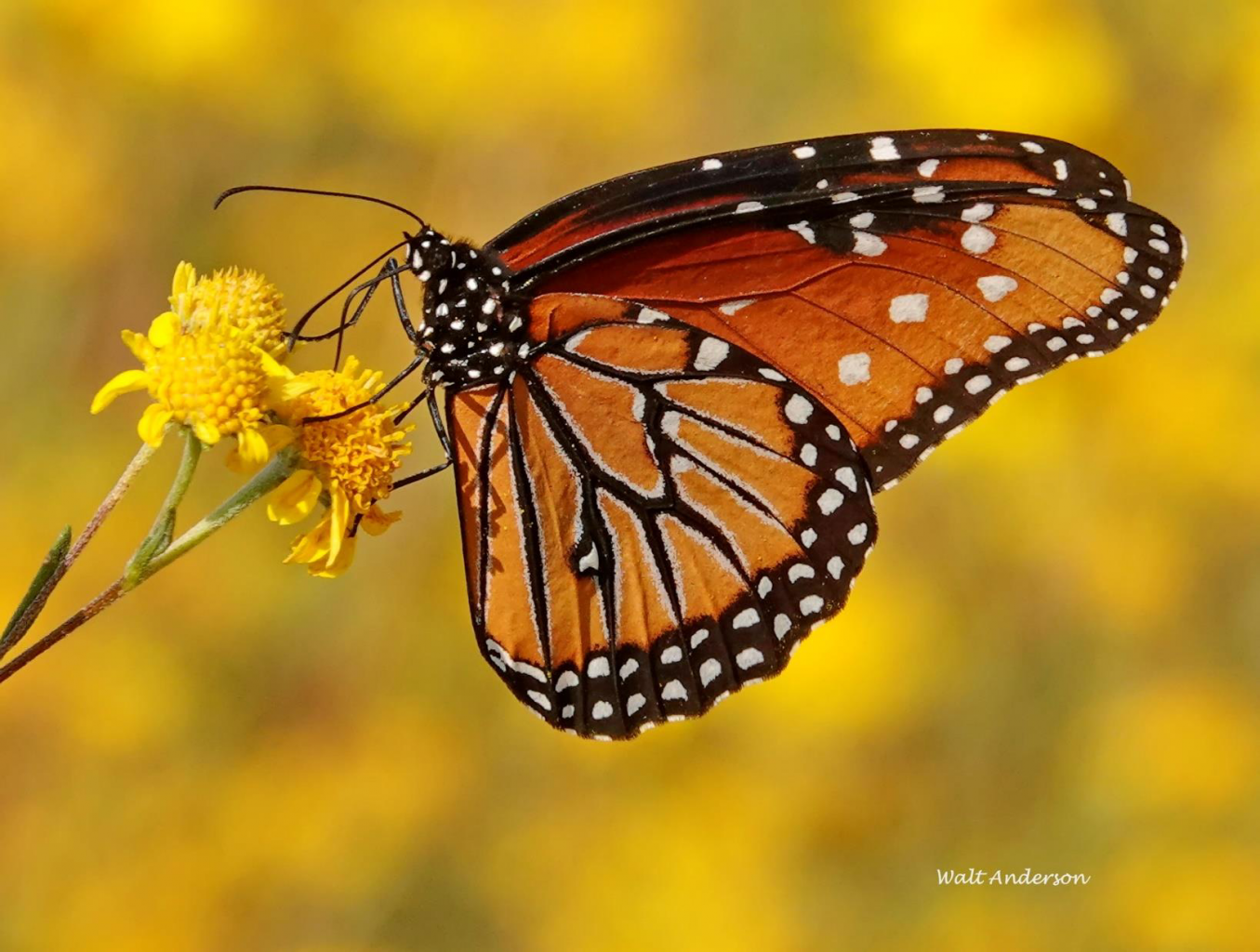
Long live the Queen!
